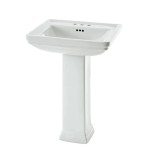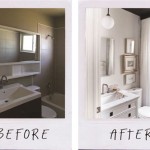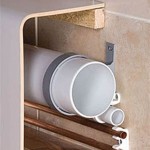Bathroom Sink Consoles: A Vintage Charm for Modern Spaces
Bathroom sink consoles, particularly those with a vintage aesthetic, offer a distinctive blend of functionality and style. These fixtures, often inspired by designs from the late 19th and early 20th centuries, are experiencing a resurgence in popularity as homeowners seek to inject character and personality into their bathroom spaces. A vintage bathroom sink console is typically defined by its freestanding structure, often incorporating exposed legs, ornate detailing, and a countertop surface, all contributing to a timeless and elegant appearance.
The appeal of vintage bathroom sink consoles stems from their ability to evoke a sense of history and craftsmanship. Unlike modern, built-in vanities that prioritize sleek, minimalist designs, vintage consoles often feature intricate carvings, sculpted legs, and classic hardware. This attention to detail adds a layer of sophistication and visual interest to the bathroom, transforming it from a purely functional space into a room with a strong design statement.
Selecting a vintage-inspired bathroom sink console involves careful consideration of several factors, including the overall style of the bathroom, the available space, and the desired functionality. The design should complement the existing décor and contribute to a cohesive aesthetic. The size of the console should be proportionate to the bathroom dimensions, ensuring that it does not overwhelm the space or impede movement. Features such as storage options, countertop material, and sink style should also be carefully evaluated to meet the specific needs of the homeowner.
Key Point 1: Defining Characteristics of Vintage Bathroom Sink Consoles
Vintage bathroom sink consoles are characterized by several key design elements that distinguish them from their contemporary counterparts. These elements contribute to the overall vintage aesthetic and contribute to the console’s timeless appeal. One of the most prominent features is the exposed leg structure. Unlike modern vanities, which typically conceal the plumbing and support structure behind a cabinet, vintage consoles showcase the legs, often crafted from materials such as brass, iron, or wood. These legs are frequently adorned with decorative details, such as fluting, ball-and-claw feet, or intricate carvings.
The countertop surface is another defining characteristic. Vintage consoles often feature countertops made from materials such as marble, granite, or porcelain. These materials are chosen for their durability, elegance, and ability to complement the overall design. Marble, in particular, is a popular choice due to its natural veining and luxurious appearance. The countertop may be integrated seamlessly with the sink basin or feature a separate vessel sink placed on top.
Hardware plays a crucial role in completing the vintage look. Faucets, handles, and knobs are often crafted from materials such as brass, bronze, or nickel, and feature classic designs such as cross handles, lever handles, or gooseneck spouts. These details add a touch of authenticity and contribute to the overall vintage aesthetic. The hardware should be chosen to complement the countertop material and leg structure, creating a cohesive and harmonious design.
The sink itself is an integral part of the console. Common sink styles found in vintage consoles include pedestal sinks, undermount sinks, and vessel sinks. Pedestal sinks, with their classic freestanding design, are a popular choice for smaller bathrooms. Undermount sinks, installed beneath the countertop, offer a clean and seamless look. Vessel sinks, placed on top of the countertop, add a contemporary touch while still maintaining the vintage aesthetic. The choice of sink style should be based on the available space, the desired functionality, and the overall design of the bathroom.
Key Point 2: Materials and Finishes for a Vintage Aesthetic
The selection of materials and finishes is crucial in achieving an authentic vintage look for a bathroom sink console. The materials used should be durable, aesthetically pleasing, and consistent with the design period being emulated. Common materials include wood, metal, and stone, each offering unique characteristics and contributing to the overall aesthetic.
Wood is a popular choice for the leg structure and framing of vintage consoles. Hardwoods such as oak, maple, and cherry are often used for their durability and rich grain patterns. The wood can be stained or painted to match the desired color scheme. Darker stains, such as walnut or mahogany, are often used to create a more traditional look, while lighter stains or painted finishes can create a more contemporary or cottage-style aesthetic.
Metal is another common material, particularly for the legs and hardware of vintage consoles. Brass, bronze, and iron are often used for their durability, resistance to corrosion, and ability to be molded into intricate designs. Brass and bronze can be polished to a high shine for a more formal look or left with a natural patina for a more rustic appearance. Iron is often used for its strength and durability, and can be painted or powder-coated to match the desired color scheme.
Stone countertops, such as marble, granite, and limestone, are a key element in achieving a vintage aesthetic. Marble, with its natural veining and luxurious appearance, is a popular choice for its elegance and timeless appeal. Granite, with its durability and resistance to stains, is a practical choice for high-traffic bathrooms. Limestone, with its soft texture and warm tones, adds a touch of natural beauty. The choice of countertop material should be based on the desired aesthetic, the level of maintenance required, and the overall budget.
Finishes play a crucial role in completing the vintage look. Distressed finishes, such as antiqued paint or rubbed edges, can add a sense of age and character to the console. Polished finishes, such as chrome or nickel, can create a more formal and elegant look. Matte finishes, such as brushed nickel or oil-rubbed bronze, can add a touch of warmth and sophistication. The choice of finish should be based on the desired aesthetic and the overall design of the bathroom.
Key Point 3: Integrating Vintage Consoles into Modern Bathrooms
While vintage bathroom sink consoles evoke a sense of history, they can be seamlessly integrated into modern bathrooms. The key is to strike a balance between the vintage elements and the contemporary features of the space. This can be achieved by carefully selecting complementary materials, colors, and accessories.
One approach is to pair a vintage console with modern fixtures and fittings. For example, a console with ornate legs and a marble countertop can be paired with a sleek, minimalist faucet and a contemporary mirror. This juxtaposition of styles creates a visually interesting and dynamic space.
Another approach is to use a consistent color palette throughout the bathroom. Neutral colors, such as white, gray, and beige, can create a calming and sophisticated atmosphere. Pops of color can be added through accessories such as towels, artwork, or plants. The color palette should complement the materials and finishes of the console, creating a cohesive and harmonious design.
Lighting is also an important consideration. A combination of natural and artificial light can create a warm and inviting atmosphere. Vintage-inspired light fixtures, such as sconces or pendant lights, can add a touch of authenticity to the space. Dimmable lighting can be used to create a relaxing ambiance. The lighting should be positioned to highlight the features of the console and enhance the overall design of the bathroom.
Storage is an essential consideration in any bathroom. While vintage consoles may not offer as much storage as modern vanities, clever storage solutions can be incorporated into the design. Open shelving beneath the console can be used to display towels or decorative items. Baskets or containers can be used to organize toiletries and other essentials. A medicine cabinet or wall-mounted shelving unit can provide additional storage space without cluttering the countertop.
Ultimately, integrating a vintage bathroom sink console into a modern bathroom is about creating a space that is both functional and aesthetically pleasing. By carefully selecting complementary materials, colors, and accessories, homeowners can create a bathroom that is both timeless and contemporary, reflecting their personal style and preferences.
The enduring appeal of vintage bathroom sink consoles lies in their ability to add character, elegance, and a sense of history to modern bathrooms. By understanding the defining characteristics, materials, and finishes of these fixtures, homeowners can create a bathroom that is both functional and aesthetically pleasing, a true reflection of their personal style.

Bristol Console Sink Vintage Tub Bath

30 Console Lavatory Sink Vintage Tub Bath

White Vintage Bathroom Console Sink 36 W 2 Spindle Leg Widespread Faucet Holes Renovators Supply Com

Lavatory Consoles Victorian Style 2 Legged Bathroom Sinks

Atwell 34 Inch Console Sink With Porcelain Legs Vintage Tub Bath

Antique Cream Pale Jade Porcelain Console Sink Heavy Chrome

1957 Vintage Standard China Console Sink Dea Bathroom Machineries

Vintage Bathroom Console Sink Collection Tub Bath

1950 S Vintage Crane Criterion Lavatory Console Sink Dea Bathroom Machineries

36 Inch Single Sink Bathroom Vanity In Antique Coffee
Related Posts







